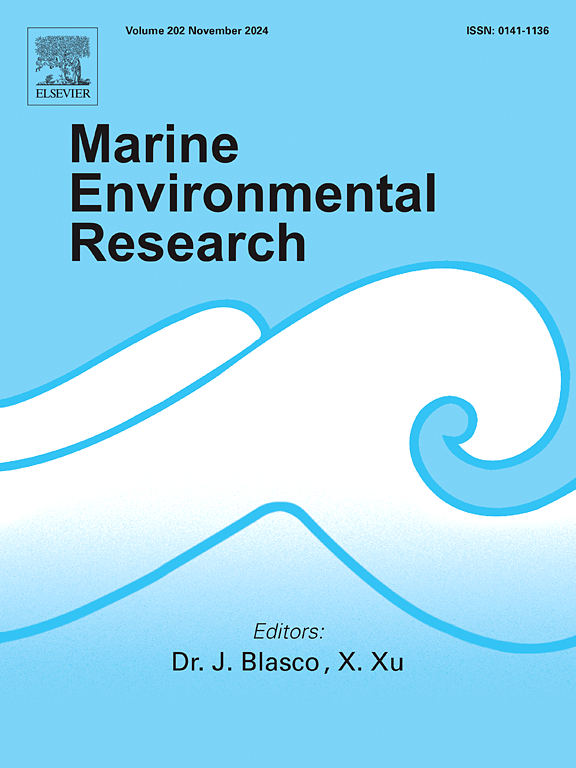Assessing the vulnerability of commercial bivalves to intensifying atmospheric heatwaves in coastal ecosystems
IF 3
3区 环境科学与生态学
Q2 ENVIRONMENTAL SCIENCES
引用次数: 0
Abstract
Heatwaves are expected to intensify and become more frequent throughout the 21st century, posing significant threats to coastal ecosystems and socio-economically important species. Shellfisheries based on intertidal and shallow subtidal infaunal bivalves such as Ruditapes decussatus, Ruditapes philippinarum, Venerupis corrugata, and Cerastoderma edule are of significant socio-economic importance in Europe, particularly in the Galician Rías Baixas (NW Spain). This study evaluates how future atmospheric heatwaves may compromise the thermal dynamics of these four commercially important bivalves in the Ría de Arousa. Global atmospheric and oceanic climate data from CMIP6 were downscaled using the WRF and Delft3D-FLOW models. The WRF model was used to characterize atmospheric heatwaves for the period 2025–2099 under the SSP2-4.5 and SSP5-8.5 pathways, while the Delft3D-FLOW model calculated bottom water temperatures under the SSP5-8.5 pathway during the most intense future atmospheric heatwave. Thermal exposure on bivalves was evaluated using a 1D sediment heat transport model. The analysis of atmospheric heatwaves revealed a total of 88 events projected throughout the 21st century, with an increase of the frequency, duration, and intensity over time, particularly during summer months. A significant increase in bottom water temperature in the estuary's inner areas was simulated under the most intense future atmospheric heatwave, driven by extreme air temperature and calm winds. The species V. corrugata and C. edule experienced the longest exposure to high temperatures, linked to their shallower burrowing depths and lower thermal tolerance, while R. decussatus and R. philippinarum remained unaffected during the atmospheric heatwave simulated. These findings highlight the vulnerability of certain bivalve species to intensifying heatwaves, which could lead to greater socioeconomic consequences.

评估商业双壳类动物对沿海生态系统中日益加剧的大气热浪的脆弱性
预计热浪将在整个21世纪加剧并变得更加频繁,对沿海生态系统和重要的社会经济物种构成重大威胁。在欧洲,特别是在加利西亚Rías Baixas(西班牙西北部),以潮间带和浅水潮下双壳类为基础的贝类渔业具有重要的社会经济意义,如decussatus Ruditapes、菲律宾Ruditapes、Venerupis walgata和Cerastoderma edule。这项研究评估了未来的大气热浪如何影响Ría de a这四种具有重要商业价值的双壳类动物的热动力学。利用WRF和Delft3D-FLOW模式缩小了CMIP6的全球大气和海洋气候数据。WRF模式在SSP2-4.5和SSP5-8.5路径下对2025-2099年的大气热浪进行了表征,Delft3D-FLOW模式在SSP5-8.5路径下计算了未来最强烈大气热浪的底水温度。采用一维沉积物热输运模型对双壳类动物的热暴露进行了评估。对大气热浪的分析显示,预计在整个21世纪共发生88次事件,其频率、持续时间和强度随着时间的推移而增加,特别是在夏季。在未来最强烈的大气热浪下,在极端气温和平静风的驱动下,模拟了河口内部区域底部水温的显著升高。V.瓦楞纸和C. edule在高温下暴露的时间最长,这与它们较浅的穴居深度和较低的耐热性有关,而R. decussatus和R. philippinarum在模拟的大气热浪中不受影响。这些发现强调了某些双壳类物种对日益加剧的热浪的脆弱性,这可能导致更大的社会经济后果。
本文章由计算机程序翻译,如有差异,请以英文原文为准。
求助全文
约1分钟内获得全文
求助全文
来源期刊

Marine environmental research
环境科学-毒理学
CiteScore
5.90
自引率
3.00%
发文量
217
审稿时长
46 days
期刊介绍:
Marine Environmental Research publishes original research papers on chemical, physical, and biological interactions in the oceans and coastal waters. The journal serves as a forum for new information on biology, chemistry, and toxicology and syntheses that advance understanding of marine environmental processes.
Submission of multidisciplinary studies is encouraged. Studies that utilize experimental approaches to clarify the roles of anthropogenic and natural causes of changes in marine ecosystems are especially welcome, as are those studies that represent new developments of a theoretical or conceptual aspect of marine science. All papers published in this journal are reviewed by qualified peers prior to acceptance and publication. Examples of topics considered to be appropriate for the journal include, but are not limited to, the following:
– The extent, persistence, and consequences of change and the recovery from such change in natural marine systems
– The biochemical, physiological, and ecological consequences of contaminants to marine organisms and ecosystems
– The biogeochemistry of naturally occurring and anthropogenic substances
– Models that describe and predict the above processes
– Monitoring studies, to the extent that their results provide new information on functional processes
– Methodological papers describing improved quantitative techniques for the marine sciences.
 求助内容:
求助内容: 应助结果提醒方式:
应助结果提醒方式:


